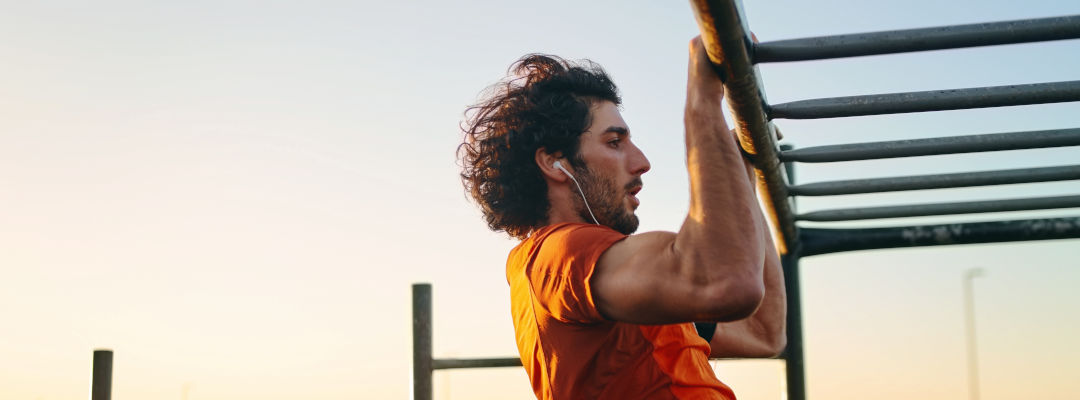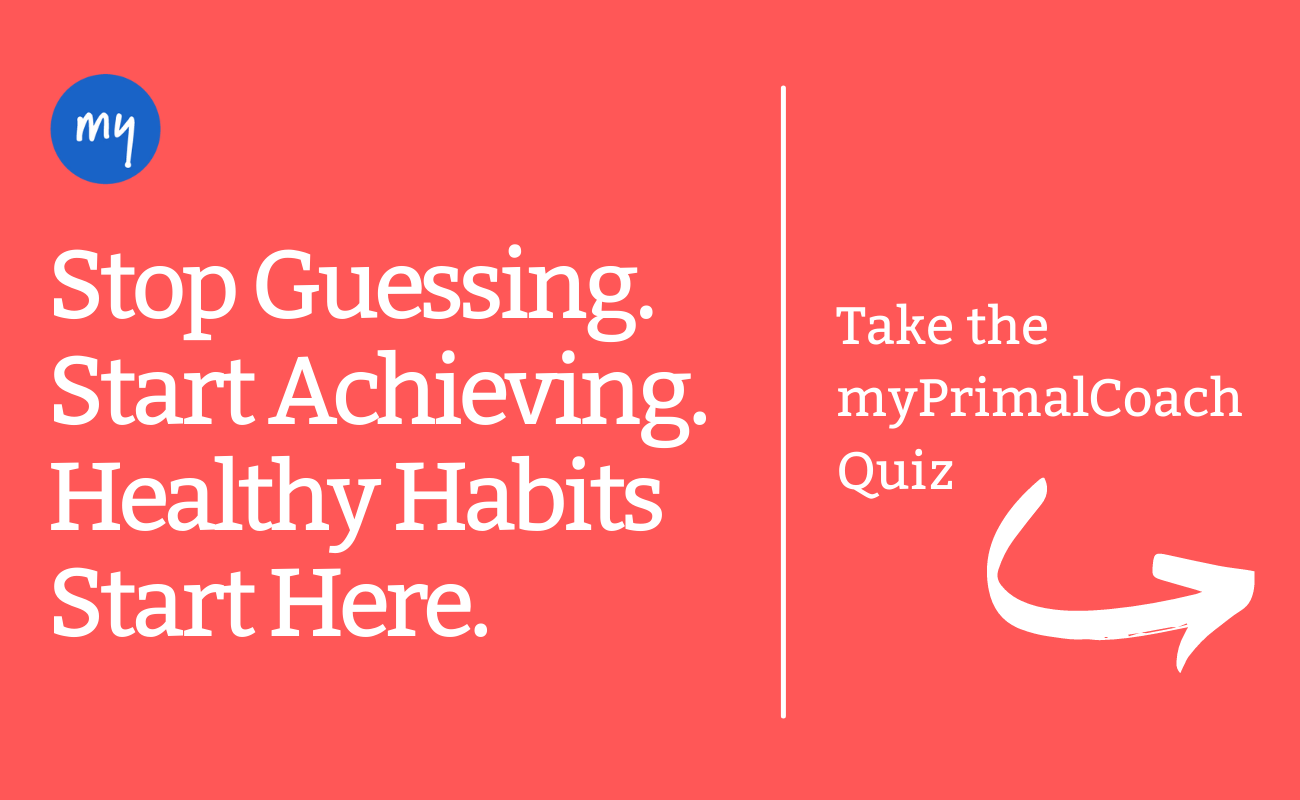The Primal Essential Movements (PEM) are four of the most simple and effective exercises ever known to mankind: push-ups, pull-ups, squats, and planks.
Collectively, these exercises work all the muscles in your body and support functional fitness for athletic and daily life activities. They’re representative of the movements our bodies have executed (in some semblance or another) on a daily, near-constant basis to promote survival for over two million years. In other words, your body was built for them.

Pull-ups: One of the Primal Essential Movements
The PEMs can be done virtually anywhere with no equipment (save a bar for pull-ups), with no expert guidance or knowledge required, and with little injury risk when done properly.
Progressions for All Levels
Because everyone is starting at a different strength, each PEM activity offers two progression exercises that are less difficult than the baseline PEM. Starting with the more accessible progression exercise makes it easier to reach a sufficient number of repetitions. For example, doing push-ups with hands elevated, such as resting on a bench, will help you complete a significant number of reps and stimulate the same muscle groups as a regular push-up would.
After steady improvement at a particular progression exercise, you can try the next more difficult progression exercise, and continue to work toward the goal of eventually reaching the mastery level for each of the baseline PEMs. From there, you can pursue more creative and challenging advanced level exercises, such as doing the PEMs with a weighted vest or elevating the legs for decline push-ups or planks.
A full training session might be made up of two to three sets of maximum repetitions for each of the PEMs (with rest intervals between 30 and 60 seconds), while an abbreviated session might include one to two sets of each PEM.
How to Conduct a PEM Assessment
Before jumping into a strength-training session, it’s important to assess your skill level and adjust accordingly. Each PEM is broken down into three skill levels: Easy, Intermediate, and Baseline (which indicates mastery of the pose).
Start by determining the skill level that allows for the maximum number of reps. For example, if you’re a female starting with Incline Push-ups, you must be able to complete 25 reps. If you can’t, drop down a level to the Wall Push-up and complete the recommended 30 reps. If you were to exceed the standard 25 Incline Push-ups, then you should bump up to Baseline Push-ups with 20 reps on future workouts.
Once levels are determined for each PEM, maintain for two to three workouts. When the maximum number of reps can be increased by approximately 20 percent, bump up to the next PEM progression exercise. In a few months time, you should be able to achieve the Baseline Essential Movement Mastery for each PEM.
Striving for Essential Movement Mastery
The following essential mastery movements are broken down according to gender and represent one set of maximum effort. If unable to perform the recommended number of reps, step down a skill level.
Males
- 50 Baseline Push-ups
- 12 Baseline Overhand Grip Pull-ups
- 50 Baseline Squats
- 2-minute hold of Baseline Forearm/Feet Plank
Females
- 20 Baseline Push-ups
- 5 Baseline Overhand Grip Pull-ups
- 50 Baseline Squats
- 2-minute hold of Baseline Forearm/Feet Plank
It’s All in the Technique
Before you dive into a PEM session, review the progression exercises to make sure you’re using proper form.
Push-ups
With an emphasis on chest, shoulders, and triceps, push-ups work your entire upper body, including your abdominal muscles. Lats, traps, and abs stabilize the muscles that are pushing up, while an engaged lower back, legs, and glutes keep your hips stabilized.
Video from Mark’s Daily Apple.
Wall Push-up (Easy)
Face a wall and extend your arms straight in front of you. Keeping your body straight from head to toe, bend your arms and allow your body weight to collapse toward the wall until your face is touching or very close to the wall. Straighten your arms to return your body to a vertical position, parallel to the wall.
Maximum Reps — Male (50 reps) and Female (30 reps)
Incline Push-up (Intermediate)
Incline Push-ups include any range of inclines between Wall Push-ups and regular push-ups. A Wall Push-up (nearly vertical body) is the easiest, and you can progress closer to horizontal (regular push-up) as strength improves.
Assume push-up position but with hands resting on an elevated object, such as a chair or a bench. Lower your chest to the object, pause, push up, and repeat. The arms should bend past 90 degrees as measured along the outside of the elbow—the lower the better!
Maximum Reps — Male (50 reps) and Female (25 reps)
Baseline Push-Up (Essential Mastery Movement)
Assume plank position: arms extended, shoulder-width apart, with hands pointing forward. Lower to the ground (chest touching first), pause, push up. Keep your body straight, core and glutes tight, elbows in and bending backwards at 45-degree angles.
Maximum Reps — Male (50 reps) and Female (20 reps)
Pull-ups
Our primal ancestors had to pull their body weight up and over cliffs, branches, vines, and trees in order to survive. Primal fitness requires that the modern human have the same capacity to manipulate his or her body weight on the vertical plane. Pull-ups force you to use your entire body weight. If you are good at pull-ups and chin-ups, you possess, by definition, a superior strength-to-weight ratio.
Video from Mark’s Daily Apple.
Chair-Assisted Pull-up (Easy)
Place a support chair underneath the pull-up bar. Put your leg(s) lightly on the chair (you are aiming to support the majority of your body weight with the pull-up bar). Try to use only one leg for support if possible. Engage your upper body muscles, using just enough leg force to help you reach your chin over the bar. Repeat.
Note: You can also do assorted pull-up maneuvers in the gym that allow the body to be grounded and closer to horizontal. For example, use straps hanging from the ceiling or even a barbell resting on a bench press rack.
Maximum Reps — Male (20 reps) and Female (15 reps)
Chin-up (Inverted Grip) (Intermediate)
Chin-ups tend to be slightly easier than pull-ups, especially for those with wrist, elbow, or shoulder conditions. Begin from a dead hang, with arms fully extended and hands shoulder-width apart. Palms face toward the body. Keep the chest straight, the shoulders back and tight, and eyes on the bar above. Pull yourself up toward the bar, leading with the chest and driving your elbows toward the floor. Clear the bar with your chin. Lower in a controlled fashion and repeat.
Maximum Reps — Male (7 reps) and Female (4 reps)
Baseline Pull-ups (Overhand Grip) (Essential Mastery Movement)
Match the form of chin-ups, but with the palms facing away from the body. Keep elbows tight, chin tucked, and shoulder blades retracted to protect the spine. Lead with your chest up, keeping your lower body still. Do not swing your hips and legs for momentum. Raise your chin over the bar and gradually lower all the way down to a dead hang. Do not strain to lift your chin above the bar, as doing so can pinch a nerve and cut off muscular power. Repeat.
Maximum Reps — Male (12 reps) and Female (5 reps)
Squats
If you want to retain mobility throughout your life, squatting is essential. It’s how humans lower their center of gravity, from sitting on a couch to squatting on the toilet. Practicing deep squats keeps you pliable and strong regardless of your age. If your ability to squat is poor, you will develop adverse posture and movement mechanics that will increase the strain on your spine, knees, and other joints.
It’s important to observe correct form when squatting, particularly keeping your knees tracking down in alignment with your toes as you lower. You must absolutely avoid caving the knees inward, which is the instinct when leg strength and flexibility are poor.
Many trainers recommend keeping your feet pointed straight ahead and then imagining the sensation of screwing your legs into the ground (rotating your knees and quads outward to lower, instead of inward). If you are uncomfortable lowering with legs straight ahead, you can point your feet out a few degrees. Just be sure to track your knees on the same plane as your toes. Also be sure to keep your chest facing forward, your weight balanced over your heels, and your feet flat on the ground. Some people with poor flexibility in the foot and calf tend to raise the heels off the ground when squatting.
Video from Mark’s Daily Apple.
Assisted Squat (Easy)
Hold onto a pole or other support object. Stand in a comfortable stance with feet slightly wider than hip-distance and toes turned out. Lower down—concentrate on reaching your buttocks back while keeping your lower back firm. Knees are aligned with toes, and toes remain on the ground. Rise up from a squat position and repeat. There is no intermediate level, so increase progression by using your support object as little as possible.
Maximum Reps — Male and Female (50 reps)
Baseline Squat (Essential Mastery Movement)
Stand in a comfortable stance with feet slightly wider than hip-distance and toes turned out. Lower down—concentrate on reaching your buttocks back while keeping your lower back firm. Knees are aligned with toes, and toes remain on the ground. Keep your chest up and eyes looking forward and slightly down, maintaining a neutral position with your head and a cohesive line along your spine. Squat just below parallel so that your butt drops below your knees. Rise back up by pushing through your heels, and repeat the process.
Note: The baseline squat is considered an “air” squat because you just lower and raise without any use of objects. This baseline squat can also be practiced in progression by using objects that are lower and lower to the ground to squat onto and back up. For example, start with squatting until you touch a chair or edge of a sofa and then stand back up. Then progress to squatting down to a stool or exercise ball that’s only a foot or two off the ground before rising.
Maximum Reps —Male and Female (50 reps)
Plank
Plank position is the ultimate core exercise. Core strength is important for basic athletic activities, such as carrying a heavy load of groceries or transferring power from the hips when throwing a ball. Plank ensures a stable, strong core with the capacity to resist the influence of outside forces.
Video from Mark’s Daily Apple.
Forearm/Knee Plank (Easy)
Assume a push-up position, but with forearms instead of hands on the ground. Elbows are directly underneath your shoulders. Lower your knees to the ground just as you would when performing a knee push-up. Keep your core and glutes tense and your neck and spine neutral as you hold the pose.
Male and Female (hold for 2 minutes)
Hand/Feet Plank (Intermediate)
Hold push-up position, with arms straight and toes on the ground, for two minutes. Keep your spine straight (do not cave your torso in or stick your buttocks in the air) and your glutes firm. Some exercisers with weak wrists may find these more difficult than the baseline elbow/feet plank. If so, just skip this exercise and move to the baseline plank.
Male and Female (hold for 2 minutes)
Baseline Elbow/Feet Plank (Essential Mastery Movement)
Keep forearms on the ground, aligned with shoulders. Raise onto the toes, keeping your body in a horizontal, cohesive line. Keep your core and glutes tense and your neck and spine neutral as you hold the pose. Tuck in your tailbone to alleviate back stress.
Male and Female (hold for 2 minutes)
There are variations to Baseline Plank, such as Side Plank to isolate the lateral muscles. To execute Side Plank, turn to the right side, resting your right forearm on the ground. Stack your feet on top of each other. Raise your hip so that your body is in straight head-to-toe alignment sideways, and hold for 45 seconds. Repeat on the left side.
Keep it Dynamic
Primal movements should be slightly explosive, with applied dynamic force to each repetition, and maintained at a speed that doesn’t sacrifice form or number of reps.
When applying force, exhale or hold the breath to seal the airspace in the transverse abdominal muscles of your lower core and to protect the lumbar spine. Catch your breath on an inhale during the recovery phase. If the muscles fatigue before goal reps have been achieved, take a 5- to 10-second mid-set break.
Keep the exercises moving—do as many reps as possible and then move on to the next resistance movement.
Got questions on the PEMs? That’s what your dedicated Primal Health Coach is there for. Reach out to your coach with any questions, and be sure to celebrate those progression wins!

